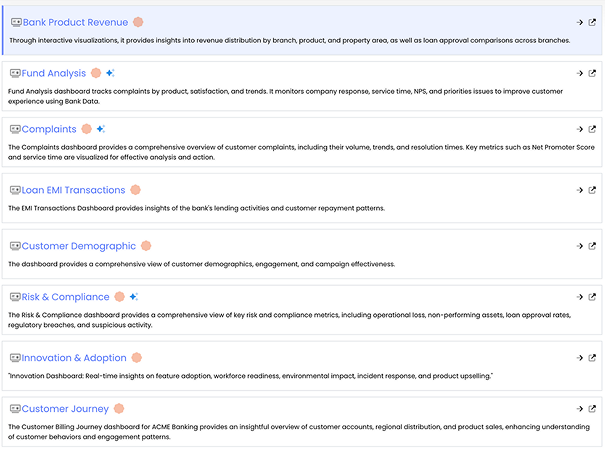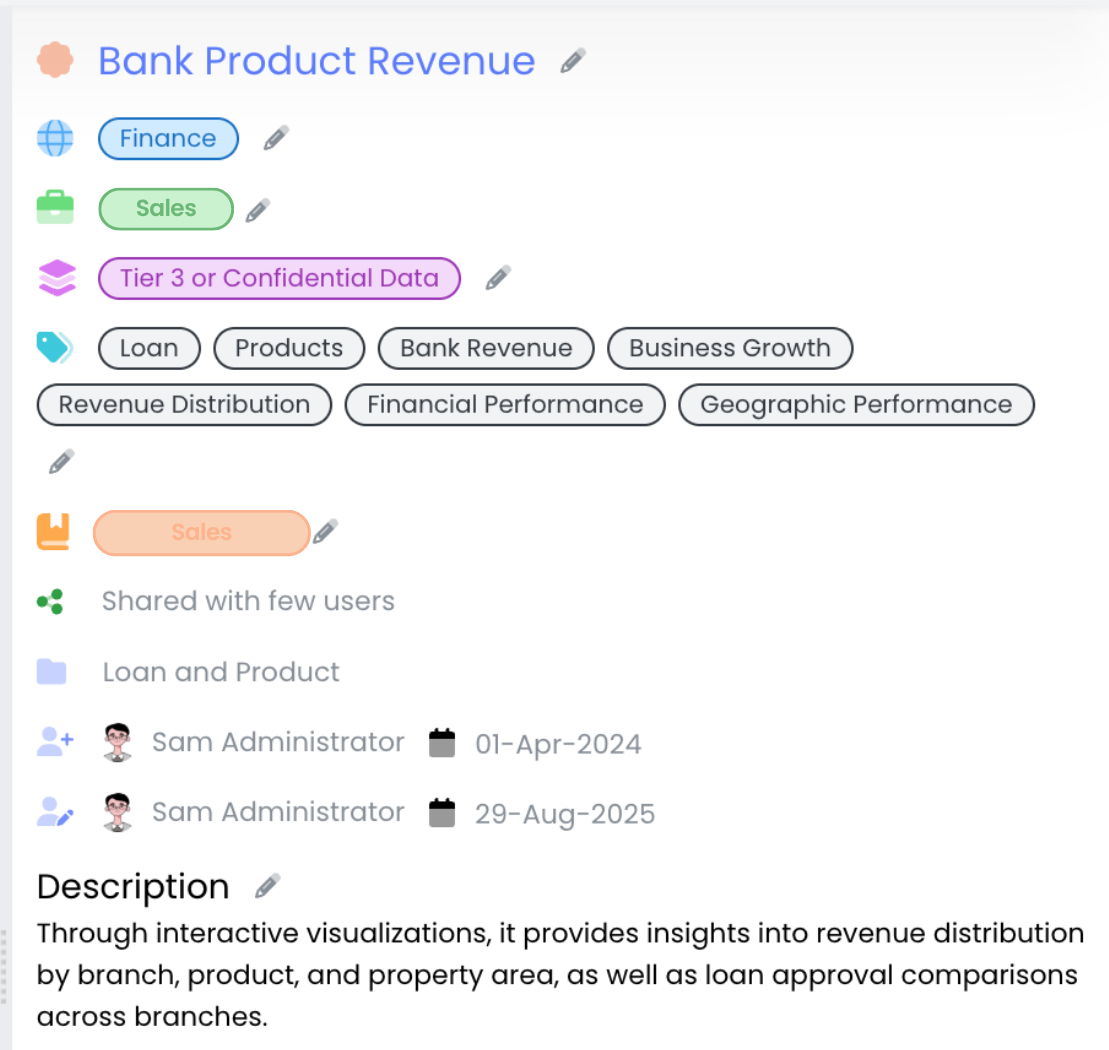Ready to revolutionize your data journey with Infoveave?
Recent Blogs
- How Data Automation And Data Engineering Are Transforming Healthcare
- How Data Automation Tools Are Transforming Manufacturing
- How Data Automation and Data Engineering Are Revolutionizing the Telecom Industry
- How Data Automation is Powering the Retail Energy Industry
- How Data Automation and Data Engineering Are Revolutionizing the Automotive Industry
Data Catalog Explained: Empowering Enterprise Data Discovery
Introduction: The challenge of finding and understanding data in large organizations
Enterprises generate massive volumes of data every day. Sales figures stream in from retail outlets, transactions flow from digital platforms, and customer interactions occur across multiple channels. Yet employees often spend more time searching for data than analyzing it. Data silos across departments, inconsistent definitions, and limited visibility make it difficult to locate the right datasets. Teams duplicate work, shadow IT environments emerge, and compliance risks grow. Without a clear view of what data exists and where to find it, organizations cannot make timely and confident decisions.
This is where a data catalog becomes essential. By providing a single, centralized inventory of every data asset, a data catalog removes the guesswork. It allows everyone from analysts to business users to locate, understand, and trust the data they need.
What is a Data Catalog?
A data catalog is a centralized inventory of an organization’s data assets, whether those assets reside in databases, cloud platforms, spreadsheets, or applications. It acts like a library index for data. Instead of searching through countless files or systems, users can visit the catalog to discover what data exists, where it lives, and how it can be used.
At its core, the catalog captures technical details such as table names, data types, and storage locations. But it goes further by enriching this metadata with business context. It documents ownership, access policies, quality scores, and definitions so that both technical and non-technical users can confidently interpret and apply the data.
Key Benefits of a Data Catalog
A well implemented data catalog delivers measurable advantages across the organization.
-
Enhanced data discovery
Users can search across all data assets using familiar business terms. Instead of relying on tribal knowledge or sending multiple emails to find the right dataset, they can quickly locate the data they need for analysis or reporting. This reduces project timelines and accelerates insight generation.
-
Improved collaboration
By providing a shared understanding of available data, a catalog breaks down silos between departments. Data owners, stewards, and consumers can communicate using the same definitions and documentation. Collaboration improves because everyone refers to a single source of truth.
-
Reduced shadow IT
When employees cannot easily find or access the data they require, they often create their own unofficial copies or systems. This shadow IT leads to duplicated work, higher costs, and compliance risks. A data catalog offers a governed environment where users can access trusted data, reducing the need for ad hoc solutions.
-
Support for compliance and governance
Regulations such as GDPR, HIPAA, or industry specific mandates demand that organizations know where their data is stored and how it is used. A catalog provides clear lineage and ownership information, making audits and regulatory reporting far easier and more accurate.
Features of an Effective Data Catalog
Not all catalogs are created equal. To deliver the promised benefits, an enterprise ready data catalog should include the following core features.
Comprehensive metadata management
The foundation of a catalog is its ability to collect and manage metadata. This includes technical metadata such as schemas, tables, and columns, as well as business metadata like data owners, definitions, and usage policies. Automated scanning and continuous updates ensure the catalog stays current as systems evolve.
Powerful search and discovery
A catalog should enable intuitive search using simple language. Users must be able to find datasets using business terms, filters, and tags. Rich previews, sample data, and usage statistics help users confirm relevance before accessing the dataset.
Business glossary
A glossary standardizes key business terms and connects them to the datasets that implement those definitions. This eliminates ambiguity and ensures everyone speaks the same language when interpreting data.
Data quality scores and profiling
Understanding the condition of data is as important as knowing it exists. Built in quality scores, profiling reports, and data lineage help users assess whether a dataset is accurate, complete, and ready for use.
Security and access control
An effective catalog respects data privacy and security policies. Role based access control, auditing, and integration with existing identity management systems protect sensitive information while still enabling discovery.
Infoveave’s Data Catalog: Making data discoverable, understandable, and trustworthy
Infoveave delivers a data catalog designed for modern enterprises that need both scale and simplicity. Its capabilities go beyond static documentation to provide a dynamic, interactive view of all data assets across the organization.


Unified discovery
Infoveave automatically scans databases, cloud platforms, and applications that are connected to register every dataset. Whether data resides in on-premise systems or multiple clouds, users can integrate data using automated workflows and view it in one place. Advanced search capabilities and filters make finding relevant data fast and intuitive.
AI-powered Data Cataloging
Create data catalogs instantly using Infoveave’s GenAI. Infoveave’s AI powered data quality engine, collaborates seamlessly with the catalog information for automated rule generation.
Rich business context
Infoveave allows data owners and stewards to add detailed descriptions, tags, and relationships, ensuring that business users can understand the purpose and meaning of each dataset. A built in business glossary links definitions to datasets for complete clarity.
Data quality and lineage
Quality scores and profiling highlight the accuracy, completeness, and consistency of data. Visual lineage maps show how data flows from source to transformation to report, helping teams trace issues and ensure compliance with regulations. Infoveave’s AI powered data quality engine, collaborates seamlessly with catalog information for automated rule generation.
Governance and security
Infoveave integrates with enterprise identity management and applies robust role based access control. Administrators can define permissions at the project or dataset level, ensuring only authorized users can view or access sensitive data. Detailed audit trails support regulatory requirements and internal governance policies.
Conclusion: Empowering users to find the data they need, when they need it
A modern enterprise cannot thrive on guesswork. Teams require quick access to trusted data to make strategic decisions, innovate, and meet regulatory demands. A data catalog provides the central map to an organization’s information, reducing time spent on searching and ensuring every user operates from a single source of truth.
Infoveave’s data catalog goes beyond traditional tools. It combines comprehensive metadata management, intuitive discovery, and robust governance with the power of AI. By making data discoverable, understandable, and trustworthy, Infoveave empowers organizations to unlock the full value of their data assets.
With Infoveave, users can stop hunting for data; instead they can start using trusted data to drive insight and growth.